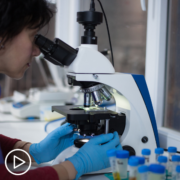Advanced Non-Melanoma Skin Cancer Treatment: Understanding Personalized Medicine
Advanced Non-Melanoma Skin Cancer Treatment: Understanding Personalized Medicine from Patient Empowerment Network on Vimeo.
Treatment for advanced non-melanoma skin cancer is becoming more personalized, but what does that mean exactly? Dr. Diwakar Davar defines personalized medicine and reviews key factors involved in determining skin cancer treatment options.
Dr. Diwakar Davar is the Clinical Director of the Melanoma and Skin Cancer Program at UPMC Hillman Cancer Center. Learn more about Dr. Davar.
See More from Evolve Non-Melanoma Skin Cancer
Related Resources
Transcript:
Katherine:
You know, Dr. Davar, we often hear this term “personalized medicine.” What does it mean?
Dr. Davar:
Personalized medicine really means individualizing the patient’s treatment for that particular patient’s tumor. No two tumors are the same. Every tumor is different just as every person is different. Therefore, identifying and crafting the optimal treatment plan really involves identifying the most available and up-to-date information about the person’s tumor and contextualizing the treatment options in that setting.
For example, in the context of Merkel cell polyoma, the virus associated with Merkel cell carcinoma, the treatment options would certainly include checkpoint inhibitor therapy with the understanding that the Merkel cell polyomavirus status could change both the response to the treatment but also the monitoring of the treatment because there is and acid that uses antibody titers to track the disease.
In the context of patients with advanced cutaneous squamous cell carcinoma, the presence or absence of intratumoral CD8 T cells very provocatively can affect the response of checkpoint inhibitor therapy. The key thing to understand about personalized medicine is the more information we have about your tumor, the more informed we are about not only your current treatment, but also what future treatments might be available to you if the current treatment stops working.
Katherine:
Aside from testing, what other factors are involved when choosing therapy?
Dr. Davar:
These factors include, particularly for non-melanoma skin cancers, the patient’s age and performance status. We do know that as patients get older, their comorbid piece changes. They have a higher risk of having concomitant second illness such as cardiac issues, diabetes, high blood pressure, cholesterol issues, strokes, and coronary artery disease.
These diseases in and of themselves do not necessarily affect one treatment choice over another, but it may change how you treat the patient. For example, a 60-year-old patient with melanoma may be a great surgical candidate. A 60-year-old patient with squamous cell carcinoma maybe a great surgical candidate. However, an 85-year-old patient with cutaneous squamous cell carcinoma with a tumor near the eye may not necessarily be a great surgical candidate because even though the tumor could be removed, it would result in the removal of that person’s eye.
If this person has already has got, for example, age-related issues with balance, age-related issues with difficulty and vision and depth perception, removing this person’s eye, which is a very morbid procedure, but can be done at relatively low surgical risk, could really affect this patient’s quality of life and may force you to rethink what you would do and may result in you offering this patient a different treatment modality such as upfront use of systemic therapy rather than a standard surgical approach.
The idea is that the more information you have about the patient, the easier it is to contextualize the treatment for a particular patient and particularly in the context of non-melanoma skin cancer, which often time happens to patients who are, on average, one decade older than patients with melanoma. Taking their age and taking their comorbid conditions is very important in determining the treatment modality and also in making individualized patient recommendations.









